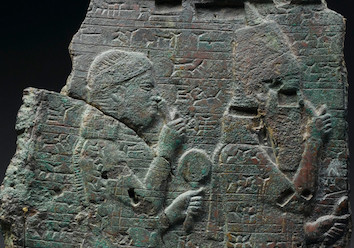Esarhaddon (r. 680–669 BC)

AO 20185, a fragment of a bronze relief depicting Naqīʾa and an Assyrian king. Photo credit: Collection of Antiquités Orientales of the Musée du Louvre.
As the de facto ruler of Babylon, Esarhaddon, the son and immediate successor of Sennacherib, sponsored numerous building activities throughout Babylonia and the East Tigris region during his twelve-year reign. According to extant cuneiform sources, mostly royal inscriptions, he had construction carried out in no less than seven Babylonian cities, including the restoration of those cities' damaged cult statues and paraphernalia. Some of the projects initiated by Esarhaddon remained unfinished at the time of his death in late 669 BC, but these were completed largely under the supervision of Ashurbanipal, a younger son of his whom he had appointed to succeed him as the king of Assyria. Esarhaddon is known to have worked on the following buildings in Babylonia:
- Agade
- Eulmaš (temple of the goddess Ištar)
- Babylon
- Eniggidrukalamasuma (temple of Nabû of the harû)
- Esagil (temple of the god Marduk)
- Etemenanki (ziggurat of the god Marduk)
- Eumuša (cella of the god Marduk)
- Imgur-Enlil and Nēmetti-Enlil (the inner city walls)
- Bāṣ
- Edurgina (temple of the god Bēl-ṣarbi)
- Borsippa
- Dais of Destinies (a seat of the god Nabû in the Ezida temple complex)
- Etila (temple of the goddess Gula/Ninkarrak)
- Ezida (temple of the god Nabû)
- Nippur
- Ebaradurgara (temple of the goddess Ištar as Šarrat-Nippur)
- Ekur (temple of the god Enlil)
- Sippar-Aruru (Dūr-Šarrukku)
- Ešeriga (temple of the god Šidada)
- Uruk
- Eanna (temple of the goddess Ištar)
- Ehiliana (cella of the goddess Nanāya in Eanna)
- Enirgalana (cella of the goddess Ištar in Eanna)
Esarhaddon also carried out construction in the East Tigris region, at Dēr, where he worked on Edimgalkalama, the temple of the god Anu rabû (Ištarān). Furthermore, Esarhaddon gave special attention to Ehulhul (temple of the god Sîn) at Harran — a large garrison and important trading center situated on the route between the Mediterranean Sea and the plains of the middle Tigris. Together with his mother Naqi'a (who also went by the name Zakutu), this Assyrian king (1) decorated Ehulhul; (2) donated metal(-plated) cult utensils; and (3) set up images of himself and his heir designates Ashurbanipal and Šamaš-šuma-ukīn, the future rulers of Assyria and Babylonia respectfully, in the vicinity of the image of the moon-god. Clearly he had more important, long-term plans for Ehulhul, but he died (late in the year 669 BC) before he could carry them out.
Jamie Novotny & Niclas Dannehl
Jamie Novotny & Niclas Dannehl, 'Esarhaddon (r. 680–669 BC)', Babylonian Temples and Monumental Architecture online (BTMAo), The BTMAo Project, a sub-project of MOCCI, [http://oracc.org/btmao/StructuresbyBuilder/Neo-AssyrianPeriod/Esarhaddon/]